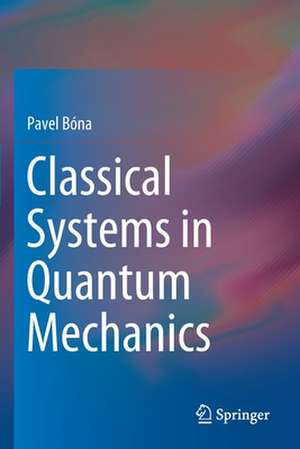Classical Systems in Quantum Mechanics
Autor Pavel Bónaen Limba Engleză Paperback – 24 iun 2021
| Toate formatele și edițiile | Preț | Express |
|---|---|---|
| Paperback (1) | 638.11 lei 6-8 săpt. | |
| Springer International Publishing – 24 iun 2021 | 638.11 lei 6-8 săpt. | |
| Hardback (1) | 644.30 lei 6-8 săpt. | |
| Springer International Publishing – 24 iun 2020 | 644.30 lei 6-8 săpt. |
Preț: 638.11 lei
Preț vechi: 750.72 lei
-15% Nou
Puncte Express: 957
Preț estimativ în valută:
122.12€ • 132.60$ • 102.58£
122.12€ • 132.60$ • 102.58£
Carte tipărită la comandă
Livrare economică 23 aprilie-07 mai
Preluare comenzi: 021 569.72.76
Specificații
ISBN-13: 9783030450724
ISBN-10: 3030450724
Ilustrații: X, 234 p. 1 illus.
Dimensiuni: 155 x 235 mm
Greutate: 0.35 kg
Ediția:1st ed. 2020
Editura: Springer International Publishing
Colecția Springer
Locul publicării:Cham, Switzerland
ISBN-10: 3030450724
Ilustrații: X, 234 p. 1 illus.
Dimensiuni: 155 x 235 mm
Greutate: 0.35 kg
Ediția:1st ed. 2020
Editura: Springer International Publishing
Colecția Springer
Locul publicării:Cham, Switzerland
Cuprins
Introduction.- Geometry of the state space of quantum mechanics.- Classical projections of quantum mechanics.- Examples of classical projections.- Macroscopic limits.- Mathematical structure of QM mean-fi eld theories.- Some models of "quantum measurement".
Notă biografică
Pavel Bona worked, until his recent retirement, as teacher and theoretician in the Department of Theoretical Physics within the Faculty of Mathematics, Physics and Informatics at Comenius University, Bratislava. He continues to publish and research in the field of quantum theory as applied also to macroscopic systems.
Textul de pe ultima copertă
This book investigates two possibilities for describing classical-mechanical physical systems along with their Hamiltonian dynamics in the framework of quantum mechanics.The first possibility consists in exploiting the geometrical properties of the set of quantum pure states of "microsystems" and of the Lie groups characterizing the specific classical system. The second approach is to consider quantal systems of a large number of interacting subsystems – i.e. macrosystems, so as to study the quantum mechanics of an infinite number of degrees of freedom and to look for the behaviour of their collective variables. The final chapter contains some solvable models of “quantum measurement" describing dynamical transitions from "microsystems" to "macrosystems".
Caracteristici
Addresses the knotty problem of the quantum-classical divide Adopts two approaches for describing classical systems in the framework of quantum mechanics Presents solvable models of the "quantum measurement" process
